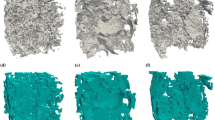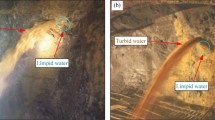Abstract
Turbulence is one of the decisive parameters that cause scouring in the river bed and threaten the foundation of hydraulic structures. And choosing the right turbulent modeling scheme is the key to simulate this flow property accurately. This study investigated a turbulent flow in a scour hole developed in a channel by using OpenFOAM toolbox. Two different turbulence schemes, k−ε and k−ω, were used to evaluate the performance of turbulent schemes in simulating the turbulence property in this complex region. Beside the main turbulence schemes, the difficulties in modeling the flow close to the wall also was solved by choosing the right wall function and boundary conditions. The results from these two models, the flow velocity profiles in streamwise and water-depth directions as well as the turbulent kinetic energy, were evaluated by comparing with the physical experimental data from previous research.
Similar content being viewed by others
References
Ahn, J. and Yang, C. T. (2015). “Determination of recovery factor for simulation of non-equilibrium sedimentation in reservoir.” International Journal of Sediment Research, Vol. 30, No. 1, DOI: 10.1016/s1001-6279(15)60007-5.
Ali, A., Sharma, R. K., Ganesan, P., and Akib, S. (2014). “Turbulence model sensitivity and scour gap effect of unsteady flow around pipe: A CFD study.” The Scientific World Journal, DOI: 10.1155/2014/412136.
Chau, K. and Jiang, Y. (2001). “3D numerical model for Pearl river estuary.” Journal of Hydraulic Engineering, Vol. 127, No. 1, 72–82, DOI: 10.1061.(ASCE)0733-9429(2001).27:1(72).
Chau, K. and Jiang, Y. (2004). “A three-dimensional pollutant transport model in orthogonal curvilinear and sigma coordinate system for Pearl river estuary.” International Journal of Environment and Pollution, Vol. 21, No. 2, 188–198, DOI: 10.1504/IJEP.2004.004185.
Dargahi, B. (1990). “Controlling mechanism of local scouring.” Journal of Hydraulic Engineering, Vol. 116, No. 10, 1197–1214, DOI: 10.1061/(ASCE)0733-9429(1990).16:10(1197).
Dimas, A. A., Fourniotis, N. Th., Vouros, A. P., and Demetracopoulos, A. C. (2008).“Effect of bed dunes on spatial development of openchannel flow.” Journal of Hydraulic Research, Vol. 46, No. 6, 802–813, DOI: 10.3826/jhr.2008.3242.
Fourniotis, N. T., Toleris, N. E., and Dimas, A. A., Demetracopoulos, A. C. (2009). “Numerical computation of turbulence development in flow over sand dunes.” Advances in Water Resources and Hydraulic Engineering, pp. 843–848, DOI: 10.1007/978-3-540-89465-0_148.
Greifzu, F., Kratzsch, C., Forgber, T., Lindner, F., and Schwarze, R. (2016). “Assessment of partical-tracking models for dispersed particleladen flows implemented in OpenFOAM and ANSYS FLUENT.” Engineering Applications of Computational Fluid Mechanics, Vol. 10, No. 1, 30–43, DOI: 10.1080/19942060.2015.1104266.
Guo, W., Hong, J., Chen, C., Su, C., and Lai, J. (2017). “A simplified simulation method for flood-induced bend scour–a case study near the Shuideliaw embankment on the Cho-Shui river.” Water, Vol. 9, pp. 324–343, DOI: 10.3390/w9050324.
Guven, A. and Gunal, M. (2010). “Hybrid modelling for simulation of scour and flow patterns in laboratory flumes.” International Journal for Numerical Methods in Fluids, Vol. 62, No. 3, 291–312, DOI: 10.1002/fld.2022.
Hoffmans, G. J. C. M. and Booij, R. (1993). “Two-dimensional modelling of local-scour holes.” Journal of Hydraulic Research., Vol. 31, No. 5, 615–634, DOI: 10.1080/00221689309498775.
Hong, J., Guo, W., Chiew, Y., and Chen, C. (2016). “A new practical method to simulate flood-induced bridge pier scour–A case study of Mingchu bridge piers on the Cho-Shui river.” Water, Vol. 8, pp. 238–251, DOI: 10.3390/w8060238.
Jellesma, M. (2013). From drag of subaqueous dune configurations, M. Sc Thesis, University of Twente, Enschede, The Netherlands.
Jones, W. P. and Launder, B. E. (1972). “The prediction of laminarization with a two-equation model of turbulence.” International Journal of Heat and Mass Transfer, Vol. 15, No. 2, 301–314, DOI: 10.1016/0017-9310(72)90076-2.
Launder, B. E. and Spalding, D. B. (1974). “The numerical computation of turbulent flows.” Computer Methods in Applied Mechanics and Engineering, Vol. 3, 269–289, DOI: 10.1016/0045-7825(74)90029-2.
Lee, H. Y. and Hsieh, H. N. (2003). “Numerical simulations of scour and deposition in a channel network.” International Journal of Sediment Research, Vol. 18, No. 1, 32–49.
Liu, X. and Garcia, M. H. (2008). “Three-dimensional numerical model with free water surface and mesh deformation for local sediment scour.” Journal of Waterway, Port, Coastal, and Ocean Engineering, Vol. 134, No. 4, 203–217, DOI: 10.1061/(ASCE)0733-950X(2008).34:4(203).
Menter, F. R. (1993). “Zonal two equation k-? turbulence models for aerodynamic flows.” Proc. 24th Fluid Dynamics Conference, AIAA, Florida, USA.
Mikuz, B. and Tiselj, I. (2014). “Numerical simulations of a turbulent flow in a fuel assembly.” Proc. 23rd International Conference Nuclear Energy for New Europe, Slovenia.
Mou, B., He, B., Zhao, D., and Chau, K. (2017). “Numerical simulation of the effects of building dimensional variation on the wind pressure distribution.” Engineering Applications of Computational Fluid Mechanics, Vol. 11, No. 1, 293–309, DOI: 10.1080/19942060. 2017.1281845.
Nagata, N., Hosoda, T., Nakato, T., and Muramoto, Y. (2005). “Threedimensional numerical model for flow and bed deformation around river hydraulic structures.” Journal of Hydraulic Engineering, Vol. 131, No. 12, 1074–1087, DOI: 10.1061/(ASCE)0733-9429(2005).31:12(1074).
Nelson, J. M., Burman, A. R., Shimizu, Y., McLean, S. R., Shreve, R. L. and Schmeeckle, M. (2005). “Computing flow and sediment transport over bedforms.” River, Coastal and Estuarine Morphodynamics, Parker & Garcia Edition, pp. 861–872.
Neven, K., Damir, B., Gordon, G., and Eamon, M. (2010). “Monitoring of river channel morphodynamical changes in the zone of bridge piers.” Proc. 1st International Conference on Road and Rail Infrastructure, Croatia.
Nguyen, T. H. T., Ahn, J., and Park, S. W. (2018). “Numerical and physical investigation of the performance of turbulence modeling schemes around a scour hole downstream of a fixed bed protection.” Water, Vol. 10, No. 2, 103–115, DOI: 10.3390/w10020103.
Ota, K., Sato, T., and Nakagawa, H. (2016). “3D numerical model of sediment transport considering transition from bed-load motion to suspension–application to a scour upstream of a cross-river structure.” Journal of Japan Society of Civil Engineers, Vol. 4, No. 1, 173–180, DOI: 10.2208/journalofjsce.4.1_173.
Ozkan, F., Wenka, A., Hansjosten, E., Pfeifer, P., and Kraushaar-Czarnetzki, B. (2016). “Numerical investigation of interfacial mass transfer in two phase flows using the VOF method.” Engineering Applications of Computational Fluid Mechanics, Vol. 10, No. 1, 100–110, DOI: 10.1080/19942060.2015.1061555.
Prendergast, L. J. and Gavin, K. (2014). “A review of bridge scour monitoring techniques.” Journal of Rock Mechanics and Geotechnical Engineering, Vol. 6, No. 2, 138–149.
Roy, D. and Matin, M. A. (2010). “An assessment of local scour at floodplain and main channel of compound channel section.” Journal of Civil Engineering, Vol. 38, No. 1, 39–52.
Salim, M. and Cheah, S. C. (2009). “Wall y+ strategy for dealing with wallbounded turbulent flows.” Proceedings of International MultiConference of Engineers and Computer Scientists, IMECS, Hong Kong, Vol. 2.
Scholz, S. (2014). “Study on porous-medium wall functions for k-e and k-? turbulence models.” Bachelor Thesis, Stuttgart University.
Shirole, A. M. and Holt, R. C. (1991). “Planning for a comprehensive bridge safety assurance program.” Transportation Research Record, No. 1290, pp. 39–50.
Stahlmann, A. (2014). “Numerical and experimental modelling of scour at foundation structures for offshore wind turbines.” Journal of Ocean and Wind Energy, Vol. 1, No. 2, 82–89.
Sun, R., Xiao, H., and Strom, K. (2016). “Particle dynamics in selfgenerated dunes over a range of hydraulic and sediment transport conditions using LES-DEM.” Cornell University Library arXiv: 1610.03397v1[physics.geo-ph].
Van Mierlo, M. C. L. M. and de Ruiter, J. C. C. (1988). “Turbulence measurements above artificial dunes.” Delft Hydraulic Laboratory, Delft, The Netherlands.
Wilcox, D. C. (1988). “Re-assessment of the scale-determining equation for advanced turbulence models.” AIAA Journal, Vol. 26, No. 11, 1299–1310, DOI: 10.2514/3.10041.
Wu, C. L. and Chau, K. W. (2006). “Mathematical model of water quality rehabitation with rainwater utilization: A case study at Haigang.” International Journal of Environment and Pollution, Vol. 28, Nos. 3–4, pp. 534–545, DOI: 10.1504/ijep.2006.011227.
Yoon, J. Y. and Patel, V. C. (1996). “Numerical model of turbulent flow over sand dune” Journal of Hydraulic Engineering, Vol. 122, No. 1, 10–17, DOI: 10.1061/(ASCE)0733-9429(1996).22:1(10).
Yu, X. and Yu, X. (2008). “1D and 2D hydraulic simulations for bridge scour prediction: A comparative study.” 4th International Conference on Scour and Erosion, ICSE, Tokyo, Japan, pp. 226–232.
Zhou, T. and Endreny, T. A. (2013). “Reshaping of the hyporheic zone beneath river restoration structures: Flume and hydrodynamic experiments” Water Resources Research, Vol. 49, No. 8, pp. 5009–5020, DOI: 10.1002/wrcr.20384.
Author information
Authors and Affiliations
Corresponding author
Rights and permissions
About this article
Cite this article
Nguyen, T.H.T., Lee, J., Park, S.W. et al. Two-dimensional Numerical Analysis on the Flow and Turbulence Structures in Artificial Dunes. KSCE J Civ Eng 22, 4922–4929 (2018). https://doi.org/10.1007/s12205-018-0103-x
Received:
Revised:
Accepted:
Published:
Issue Date:
DOI: https://doi.org/10.1007/s12205-018-0103-x




